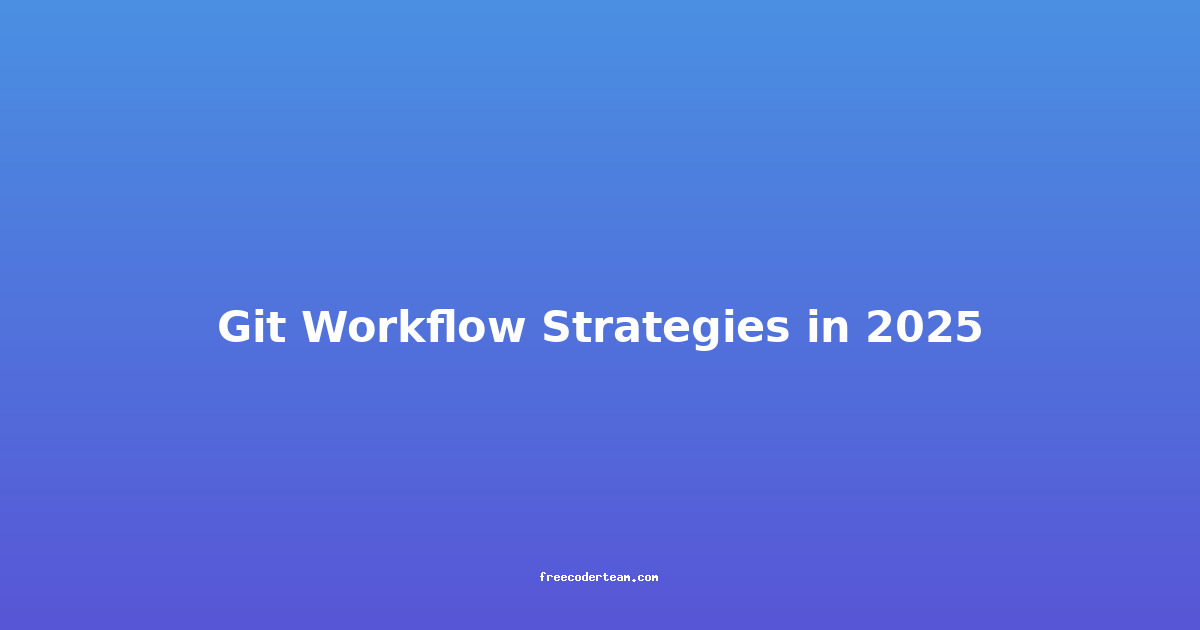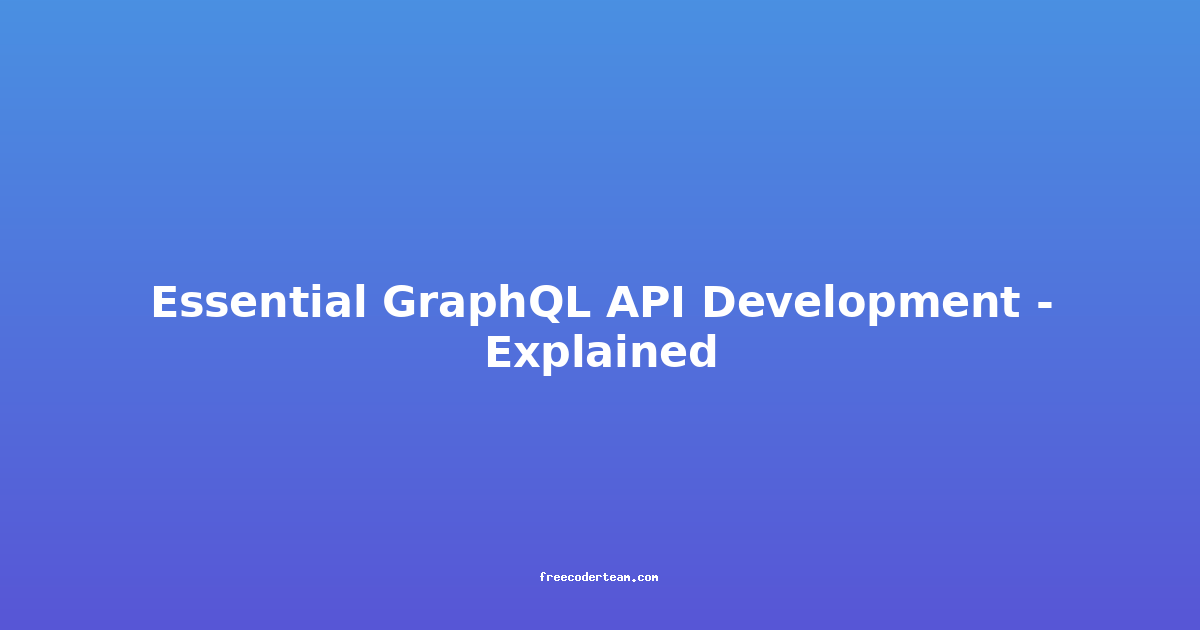Git Workflow Strategies in 2025: Best Practices and Future Insights
As we approach the year 2025, Git continues to be the gold standard for version control in software development. However, with the rapid evolution of development practices, tooling, and team structures, the way we manage Git workflows is also advancing. In this blog post, we’ll explore modern Git workflow strategies, best practices, and actionable insights to help teams stay efficient, collaborative, and future-ready.
Table of Contents
- Introduction to Modern Git Workflows
- Key Trends in Git Workflows for 2025
- Best Practices for Effective Git Workflows
- Practical Examples and Implementations
- Actionable Insights and Future Trends
- Conclusion
Introduction to Modern Git Workflows
Git workflows are no longer one-size-fits-all. They have evolved to accommodate diverse team structures, rapid development cycles, and distributed work environments. In 2025, the focus is on workflows that balance agility with maintainability, ensuring that teams can deliver high-quality software while maintaining codebase integrity.
Key Trends in Git Workflows for 2025
1. Remote-First Workflows
With the rise of remote and hybrid work models, Git workflows are increasingly designed to support distributed teams. Remote-first strategies prioritize clear communication, asynchronous collaboration, and robust automated tools to minimize context switching and ensure that everyone is on the same page.
Key Features:
- Centralized Repositories: Teams rely on central repositories (like GitHub, GitLab, or Bitbucket) as the single source of truth.
- Branching for Clarity: Feature branches and pull requests help remote team members track changes and provide feedback asynchronously.
2. Feature Branching and Trunk-Based Development
In 2025, feature branching and trunk-based development (TBD) remain popular, but their implementation is more nuanced. Feature branching is ideal for large teams working on complex features, while trunk-based development excels in smaller teams that prioritize continuous integration.
Key Features:
- Feature Branching: Teams use dedicated branches for features, allowing developers to work independently before merging changes into the main branch.
- Trunk-Based Development: Code is merged into the main branch frequently, ensuring that the trunk (main branch) is always deployable.
3. GitOps and Continuous Integration/Deployment
GitOps, a practice that treats infrastructure and application deployments as code, is becoming more prevalent. Combined with CI/CD pipelines, GitOps ensures that changes in the codebase are automatically reflected in production environments, reducing manual intervention and increasing deployment reliability.
Key Features:
- Declarative Infrastructure: Infrastructure as Code (IaC) tools like Terraform and Kubernetes manifests are stored in Git repositories.
- Automated Deployments: CI/CD pipelines trigger deployments based on git push events, ensuring that changes are deployed consistently and reliably.
Best Practices for Effective Git Workflows
1. Branch Naming Conventions
Consistent and meaningful branch naming is crucial for maintaining clarity in large repositories. In 2025, teams are adopting more standardized conventions to ensure that everyone understands the purpose of each branch.
Best Practices:
- Use Descriptive Names: Branch names like
feature/add-user-authenticationorbugfix/resolve-login-issueprovide immediate context. - Prefixes for Clarity: Use prefixes like
feature/,bugfix/,hotfix/, orrelease/to categorize branches.
Example:
# Create a feature branch
git checkout -b feature/add-user-authentication
# Merge feature branch into main
git checkout main
git merge feature/add-user-authentication
git branch -d feature/add-user-authentication
2. Pull Request Reviews
Pull requests (PRs) are the cornerstone of modern Git workflows. In 2025, teams are focusing on making PR reviews more efficient and actionable.
Best Practices:
- Code Review Guidelines: Establish clear guidelines for what reviewers should focus on (e.g., code quality, security, test coverage).
- Automated Reviews: Tools like GitHub Actions or GitLab CI can automate basic checks (e.g., linting, unit tests) before PRs are reviewed by humans.
Example:
# Create a pull request
git checkout main
git pull
git checkout -b feature/add-user-authentication
# Make changes and commit
git add .
git commit -m "Add user authentication feature"
git push origin feature/add-user-authentication
3. Automated Testing and Validation
In 2025, automated testing is no longer optional—it’s expected. Teams are integrating CI/CD pipelines with Git to ensure that every commit passes a battery of tests before being merged.
Best Practices:
- Continuous Integration: Use tools like Jenkins, GitHub Actions, or GitLab CI to run tests automatically.
- Test Coverage Metrics: Track test coverage to ensure that new features are sufficiently tested.
Example:
# GitHub Actions CI/CD Pipeline
name: CI/CD Pipeline
on:
push:
branches:
- main
pull_request:
branches:
- main
jobs:
build:
runs-on: ubuntu-latest
steps:
- uses: actions/checkout@v2
- name: Set up Python
uses: actions/setup-python@v2
with:
python-version: '3.9'
- name: Install dependencies
run: |
python -m pip install --upgrade pip
pip install -r requirements.txt
- name: Run tests
run: pytest
Practical Examples and Implementations
Example 1: Feature Branch Workflow
In this example, a team is using a feature branch workflow to develop a new feature.
Steps:
-
Create a Feature Branch:
git checkout main git pull git checkout -b feature/add-user-authentication -
Develop and Commit:
# Make changes and commit git add . git commit -m "Implement user authentication logic" git push origin feature/add-user-authentication -
Create a Pull Request:
- Open a pull request from
feature/add-user-authenticationtomain. - Request reviews from team members.
- Open a pull request from
-
Merge and Cleanup:
git checkout main git pull git merge feature/add-user-authentication git branch -d feature/add-user-authentication
Example 2: GitOps Pipeline
In this example, a team is using GitOps to deploy a Kubernetes application.
Steps:
-
Update Kubernetes Manifests: Modify the Kubernetes YAML files to reflect changes in the application.
-
Commit and Push:
git add . git commit -m "Update Kubernetes manifests for new feature" git push origin main -
Trigger CI/CD Pipeline:
- The CI/CD pipeline (e.g., GitHub Actions) detects the push to the
mainbranch. - It runs tests and deploys the application to the Kubernetes cluster.
- The CI/CD pipeline (e.g., GitHub Actions) detects the push to the
-
Monitor and Validate: Use tools like Prometheus and Grafana to monitor the deployment and ensure it’s functioning as expected.
Example CI/CD Pipeline:
name: GitOps Deployment
on:
push:
branches:
- main
jobs:
deploy:
runs-on: ubuntu-latest
steps:
- uses: actions/checkout@v2
- name: Set up Kubernetes
uses: azure/k8s-helm-login-action@v1
with:
kube-config: ${{ secrets.KUBE_CONFIG }}
- name: Deploy to Kubernetes
run: |
kubectl apply -f kubernetes/deployment.yaml
kubectl apply -f kubernetes/service.yaml
Actionable Insights and Future Trends
-
Adopt Remote-Friendly Practices: Ensure that your Git workflow supports remote collaboration by leveraging tools like GitHub Discussions, code annotations, and automated reviews.
-
Leverage AI and ML: In the near future, AI-driven code reviews and automated refactoring tools will become more mainstream, helping teams identify issues more quickly.
-
Focus on Security: As GitOps gains popularity, teams must prioritize security by implementing role-based access controls, image scanning, and vulnerability checks in their pipelines.
-
Embrace Distributed Version Control: While Git remains dominant, tools like GitLab’s Gitea or even emerging alternatives like GitLab’s GitLab Cloud are offering more distributed and decentralized options, which could reshape Git workflows in the future.
Conclusion
As we look ahead to 2025, Git workflows are becoming more sophisticated, adaptable, and integrated with modern development practices. By adopting best practices like feature branching, GitOps, and automated testing, teams can enhance collaboration, increase deployment reliability, and deliver better software. Whether your team is remote-first, hybrid, or entirely in-office, a well-designed Git workflow is essential for maintaining efficiency and scalability.
By staying aligned with these strategies and best practices, you’ll be well-equipped to navigate the evolving landscape of software development in the coming years. Happy coding!
References
Feel free to share your thoughts or questions in the comments below! 🚀




